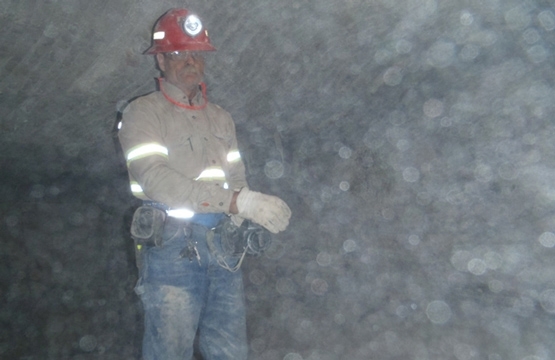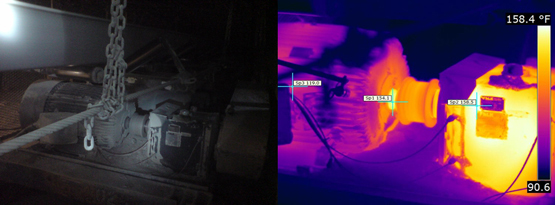
Much is written about electrical safety as it applies to infrared inspections. There are the dangers of electric shock and exposure to arc flash hazards that must be considered when inspecting electrical apparatus with thermography. What isn’t discussed nearly as often are the many hazards associated with mechanical infrared inspections.

Mechanical IR inspections can cover a very broad array of equipment. Each type of equipment can have its own distinct hazards that must be considered when performing inspections. One goal of Reliability Centered Maintenance (RCM) is improved safety, so it makes sense that one would want to employ safe practices when engaged in infrared inspections. An example below is of an exposed steam valve located on an insulated steam line that could easily be accidentally touched.

Generally speaking, the PPE requirements for mechanical infrared inspections are no different from the PPE requirements for the area that you are working in. But there are some things that are suggested above the “standard PPE” such as the wearing of a Hi-Vis vest. It is important that the thermographer stands out among the normal workers in the area. As the thermographer may not normally be working in that area, the vest lets the other workers know to be mindful of actions taken by that person and advise them of special hazards in the immediate area. A method of contact with the operators while in the area using a radio seems to work the best for communication.
One of the most obvious areas of concern is inspections of rotating equipment. Whether it’s idlers, motors, couplings, or belt-driven components, special care should be taken when working around rotating assets. Even devices driven by fractional horsepower motors generate an enormous amount of torque and can cause serious injury if your clothing, body parts, or even the strap on your camera gets caught in them. In many facilities couplings and belt-driven components are guarded for safety purposes and as such may not be readily available for inspection and modification of guards may be necessary for inspection purposes to allow access. If the removal of a guard is required, it is advisable to de-energize the rotating device in question first, if possible. Erect barricades or establish a safe work zone around the missing guard, to prevent others from incidental contact when the equipment is restarted for inspection.
Thermography is very useful for inspecting high-temperature systems such as boilers, steam lines, and kilns. Special care should be taken during an inspection of high-temperature areas for several reasons including, but not limited to:
- The surfaces being inspected could be of sufficient temperature to cause serious burns if bodily contact is made. Protective gear, such as gloves, should be considered. In some instances, steam lines and boiler skins are coated with a low-emissivity material to reduce radiant heat loss. This can present a danger to personnel in that these surfaces can often feel like they aren’t very hot from as close as an inch away, however, once contact is made and radiation is no longer the mode of heat transfer, burns can occur. Remember that low emissivity surfaces do not radiate energy very well but reflect their surroundings very well, so the camera is going to have a much lower reading than the actual surface temperature.
- If you are working in a high-temperature area for any length of time, dehydration becomes a serious concern. Protective gear can exacerbate this (there’s always a trade-off), so be sure to stay hydrated, and limit your exposure to short periods of time interspersed with breaks to cool off.
Thermography is most often accomplished in a “hands-off” or non-contact approach; the result can be a false sense of security. There are many hazards that the thermographer faces that may not be recognized by others. Slips, trips, and falls are a concern as the thermographer tends to pay more attention to the view screen on the imager, rather than the path they are walking on. Getting into awkward positions for the proper angle of view shifts the center of balance making falling more of an issue. Working in low-light areas or areas of low visibility with low overhead clearance around equipment can lead to head and neck injuries when contact is made while inspecting equipment.
Hazardous environments and or explosive environments. There are very few imaging systems that are listed as intrinsically safe for use in these locations. The imaging systems that we are using are NOT listed as intrinsically safe for these types of environments. Special procedures and permits are required and should be used.
Other special areas that could require permits are confined spaces and elevated work. These locations also may require safety lines and or fall protection that may become entangled as you work because you are paying attention to the imager screen and not the lines.
You may have heard the acronym, PJHA (Pre Job Hazard-Analysis/Assessment), these forms can be quite simple or complex, depending on the direction of the program that initiated the use. Easily modified for use of mechanical Infrared inspection on various equipment types. The accepted purpose of a PJHA is to provide a guide in the thought process to identify possible hazards and to remind the technician of the often-overlooked hazards such as, (slips, trips, falls), low overheads, protruding objects, hydration, communications, permits, etc.
Remember to be safe during mechanical inspections. Attention to detail and following proper inspection procedures can help you stay safe while you Think Thermally®.